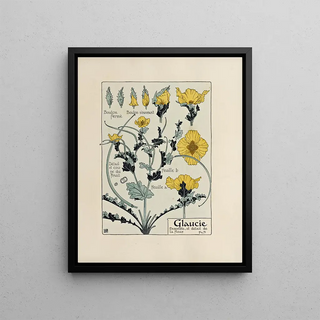Art print | Glaucie - Maurice Pillard Verneuil


View from behind

Frame (optional)
Glaucie - Maurice Pillard Verneuil Art print – Captivating introduction
In the fascinating world of decorative arts, "Glaucie" by Maurice Pillard Verneuil emerges as an iconic piece, bearing witness to an era where aesthetics and functionality blended harmoniously. This artwork, which captures the very essence of feminine beauty, invites the viewer on a sensory journey through delicate forms and rich colors. Contemplating this Glaucie - Maurice Pillard Verneuil art print, one is immediately transported to a world where every detail is carefully crafted to evoke an atmosphere of dream and serenity.
Style and uniqueness of the work
The uniqueness of "Glaucie" lies in its Art Nouveau style, characterized by flowing lines and organic motifs. Verneuil, with his mastery of decorative techniques, manages to create a piece where nature and art meet in a subtle way. The graceful curves that compose the female figure's body, as well as the surrounding floral elements, illustrate a deep connection with nature. Each element of this composition seems to dance, evoking a lightness and elegance at the heart of Art Nouveau aesthetics. The colors, soft and nuanced, add an extra dimension to the work, creating a play of light and shadow that captures the eye and stimulates the imagination. Thus, "Glaucie" is not just a simple representation but becomes a true visual poem, celebrating beauty in all its forms.
The artist and his influence
Maurice Pillard Verneuil, an emblematic figure of the Art Nouveau movement, knew how to mark his era with his innovative approach to decorative arts. Born in 1856, this French artist was influenced by the artistic currents of his time, while developing a personal style unique to him. Verneuil collaborated with numerous artisans and designers, contributing to the rise of an aesthetic that values art in everyday life. His work has not only enriched the French artistic heritage but has also inspired generations of artists worldwide. By incorporating elements of nature into his creations, he paved the way for a new way of designing

Matte finish

View from behind

Frame (optional)
Glaucie - Maurice Pillard Verneuil Art print – Captivating introduction
In the fascinating world of decorative arts, "Glaucie" by Maurice Pillard Verneuil emerges as an iconic piece, bearing witness to an era where aesthetics and functionality blended harmoniously. This artwork, which captures the very essence of feminine beauty, invites the viewer on a sensory journey through delicate forms and rich colors. Contemplating this Glaucie - Maurice Pillard Verneuil art print, one is immediately transported to a world where every detail is carefully crafted to evoke an atmosphere of dream and serenity.
Style and uniqueness of the work
The uniqueness of "Glaucie" lies in its Art Nouveau style, characterized by flowing lines and organic motifs. Verneuil, with his mastery of decorative techniques, manages to create a piece where nature and art meet in a subtle way. The graceful curves that compose the female figure's body, as well as the surrounding floral elements, illustrate a deep connection with nature. Each element of this composition seems to dance, evoking a lightness and elegance at the heart of Art Nouveau aesthetics. The colors, soft and nuanced, add an extra dimension to the work, creating a play of light and shadow that captures the eye and stimulates the imagination. Thus, "Glaucie" is not just a simple representation but becomes a true visual poem, celebrating beauty in all its forms.
The artist and his influence
Maurice Pillard Verneuil, an emblematic figure of the Art Nouveau movement, knew how to mark his era with his innovative approach to decorative arts. Born in 1856, this French artist was influenced by the artistic currents of his time, while developing a personal style unique to him. Verneuil collaborated with numerous artisans and designers, contributing to the rise of an aesthetic that values art in everyday life. His work has not only enriched the French artistic heritage but has also inspired generations of artists worldwide. By incorporating elements of nature into his creations, he paved the way for a new way of designing






